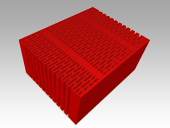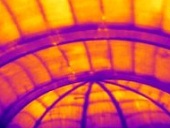Causes of failures and errors in building basement are worse distinguishable than causes of errors of building above ground. For the poor, sometimes even impossible access to the basement and the underlying structure, the method of remediation is difficult. Humidity is one of the most feared cause of failures.
Archiv článků od 4.4.2011 do 3.10.2011
Setting the real price for water treatment will cause increasing of the decentralized solutions. For objects without a continuous operation a septic tank is suitable in combination with final water purification system. What the Building Act, Water Act and other regulations? The interpretation of current legislation for sewage disposal is object of this paper.
Causes of failures and errors in building basement are worse distinguishable than causes of errors of building above ground. For the poor, sometimes even impossible access to the basement and the underlying structure, the method of remediation is difficult. Humidity is one of the most feared cause of failures.
The paper focuses on the differences between equivalent thermal conductivities of the masonry from hollow bricks in vertical and in both horizontal directions. Recent CFD studies presented the ratio between thermal conductivities in vertical and in horizontal direction (perpendicular to the surface of the masonry). This study shows the relation between thermal conductivities of the masonry in both horizontal directions.
Excessive moisture may be the objects of wooden folk buildings have a negative effect on all the wooden structures, which are these objects formed. This is because if any of the wooden elements has excessive humidity, there is a risk of assault at his wood-destroying biological pests (wood-decaying fungi, wood-destroying insects, rot and mold).
The major damages in concrete structures caused by fire are a breach of the concrete strength, the cracking, peeling, discoloration and deformation of elements. The most important are reduction in concrete strength becomes associated with its subsequent bursting. Although quantification of the main changes of the strength is unreal, it is possible to determine its damage by measuring the speed of ultrasound.
Sloping roofs meet today not only the function of protection from the rain. Use attic space for residential purposes made them cladding, which must withstand moisture influences from both the exterior and the interior. Frequently discussed issue is the composition of construction and materials used. These two factors strongly affect the hygrothermal regime in construction and thus the quality of the internal microclimate.
Experience of construction supervision show that expectations for the revitalization and rehabilitation of housing, which includes regeneration or at least repair of residential buildings are not completely fulfilled in practice. At the same time shows how the robust technical supervision for quality of work is important.
Within the grant project "Multi-storey buildings made of wood" in the laboratories of the Academy of Sciences in Prague and TAZUS performed number of tests of wooden skeleton joints with steel plates, which confirmed the theoretical assumptions and calculations, and demonstrate their reliability and functional and economic advantages for use in practice. Here are a few of the results of experimental tests.
Family houses belong among the simple structures that are usually built with a classical way. Although the technology of construction is not difficult, it is possible for gross neglect of basic technological practices and the protection of buildings during construction to cause such damage, which is difficult to repair, even for the increased financial costs. Evidence of this is an example of one family house for individual living in the suburb of Prague on the basis of expert opinion.
The aim of the research was to determine the effect of chemical degradation of the surface layers of wooden structural elements to their mechanical properties and depth to which the damage extends. Degradation of the surface layer of wood structural elements caused a chemical reaction of some compounds contained in the fire in the past repeatedly coatings applied to wood structures of historical buildings. Such chemicals include ammonium sulphate and ammonium phosphate.
This paper is focused to the fire resistance of multi-storey buildings with light wooden skeleton. Computational procedures in Eurocode are applicable simply and only for a limited number of building elements. For scientific work in this topic are indispensable fire experiments and their subsequent evaluation by means of numerical and analytical models.
This paper is based on the results of theoretical and implementation work in the development of mechanical connections with steel plates and steel elements in timber structures. The analysis of the slip of joints and support details ranks among important issues from the point of view of designing timber structures. The influence of joint stiffness on structural behaviour should be considered in modelling assumptions.
Wood pieces, even locally damaged exhibit useful stiffness and strength parameters with which they can help continue to meet current requirements - after repair. Experience with old wooden structures such as roofs of church towers demonstrate the ability of timber stored in a suitable environment to retain its material properties for many centuries.
Our serial continues with this low-energy house built with sand-lime bricks. This time, the family house is located not far from Liberec, in the foothills of the Jizera mountains. The surroundings, predominantly rural houses near a protected natural area, influenced the shape of the house. Its location responds primarily to the surrounding buildings and the slightly sloping land.
While in Germany and Austria this kind of buildings are already a common sight, in the Czech Republic it was celebrated as a local pioneer. The calcium and sand structure with a gabled roof supported by glass rubble, which was certified by the Passivhausinstitut Dr Wofgang Feist y Darmstadt, has passed a wide range of technical measurements and numerous visits. We attended one of them.
Durability and functional reliability of buildings and structures of wood and wood based materials is significantly influenced by moisture content of these materials. In the article we report the results of measurement of moisture in the wood samples mounted between the outer walls with air chambers and comparing the measured values with values calculated by us in the recommended way of moisture balance in the construction according to ČSN 73 0540.
The hot-air treatment of the roof truss of the Upper Church in the village of Velká Lhota at Dačice is documented in stepwise details as a graphical and textual presentation with supporting charts and photographs. In addition to a mycological analysis, a project preparation plan and the main heat treatment technology, a detailed operations schedule is introduced as well as temperature measurement, supporting constructions and heat penetration. The writers’ utmost objectiveness towards this method is demonstrated by thermal camera images of the critical sites and cavities attacked by fungi. The article provides a comprehensive overview of application practices with all necessary recommendations, including the final application of chemical preservatives on the already heat-treated wooden framing.
The paper is focused on some new types of timber structures made from solid timber, glued laminated timber and wood based materials. Especially glued laminated timber is a highly engineered material, because large sizes of structural members and the possibility of various shapes in beams, frames and arches are available. The analysis of intensive loaded structures with large spans shows clearly that to the most advantageous types of connections belong those made by means of steel elements. The analysis of the slip of joints and supports ranks among important issues in designing timber structures. The paper summarises some experience and conclusions from the construction of timber systems with steel-to-timber joints.
zpět na aktuální články



















